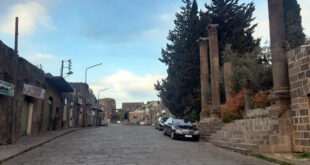Tartous, SANA – Antaradus proved not just a remarkable artistic and tourist event unique to Tartous, as it provided a miniature model of Syria, representing it in its entirety and recounting to the whole world the sorrows and hopes of the country.
At a time when the joys of tourism and cultural festivals and activities have been forcibly absent in various provinces due to the shadow of the exhausting terrorist war still grinding on since 2011, Antaradus Tourism Festival, which was held late last month on the occasion of World Tourism Day under the title “Homeland Letters,” was a special display that brought about an enlivening sense of pleasure and optimism.

With its multiple layers of entertainment, the festival, named after the Phoenician name of Tartous, conveyed messages of strong will, desire of rising again, and loyalty to the cultural and artistic legacy of the ancestors.
An awe-inspiring sense reverberated through the stage on the opening day of the festival, when Julnar lyric theatre troupe, together with members of Tartous branch of the Revolutionary Youth Union and its scouts and Atabat (thresholds) Choir, performed a “lyrical dialogue” titled “Antaradus and History” that brought to light the deeply-entrenched roots of Tartous and its remarkable cultural character over the ages.
The skillfully-performed musical play, which was presented on the corniche of Tartous, was meant to send a variety of messages, according to Director of Julnar troupe Ali Hamdan.
Speaking to SANA’s reporter, Hamdan said one of those messages was addressed to the Syrian youth who are “the hope of the homeland in salvation, awareness and reconstruction.”
He said that the second message was sent to the Syrian Arab Army to stress the people’s support for it, while a third message implied unshakable loyalty to Syria’s martyrs. Syrians living abroad were also addressed in other messages saying that the homeland “needs you now more than ever.”
“The most important of all messages is that Syria is not a desolate, ill-fated country where there is no room for anything but suffering,” said Youssef al-Muqbel, who portrayed the play’s protagonist.
“The fact is that our people seek salvation, crave life, and raise their voices in songs to assert their presence and continuity,” he added, calling upon the Syrians abroad to come home and partake in the “hope, dream, singing, and reconstruction.”
A different and no less interesting story was narrated in the garden of Tartous Museum in the form of a fashion show evoking the Phoenician, Roman, Aramaic, Umayyad, Abbasid, and Andalusian periods.
Asian and European folkloric fashion was also featured in the show, bringing to the catwalk the lineaments of the civilizations and people of Spain, India, China, France, and Britain in classic and modern forms.
The story was capped off by the Julnar models, who performed in the show, walking down the catwalk in full glamour and swaying to the music while wearing clothes from the traditional Syrian coastal fashion along with folk clothes and attires worn in Syria’s various provinces.
 To match the fantastic atmosphere in which the show was performed, Ahmad al-Teir presented an enthralling Mawlawiyah (Sufi whirling deeply rooted in oriental culture, particularly in Damascus and Aleppo) dance show, with al-Teir performing while clad in blue instead of the customary white attire associated with this tradition.
To match the fantastic atmosphere in which the show was performed, Ahmad al-Teir presented an enthralling Mawlawiyah (Sufi whirling deeply rooted in oriental culture, particularly in Damascus and Aleppo) dance show, with al-Teir performing while clad in blue instead of the customary white attire associated with this tradition.
Strewn all across the Museum’s garden were the works of sculptors and handicraft artisans, who were wearing traditional and Phoenician outfits to maintain the overwhelming harmonious mood of the festival.
Dexterously sculpted Phoenician ships and relics from Amrit, an ancient Phoenician city located near Tartous, stood out among other pieces of work that were brought together to give a glimpse into the cultural heritage of Syria, the land from which the Ugarit alphabet and ship-building industry originated.
Paintings made of silkworm cocoons and hand-painted, engraved and jewelry-inlaid silver mirrors, keepsake boxes, and accessories glittered in the park, reflecting the rich heritage of the Syrian traditional crafts.
The various stages of Antaradus festival, including the events held at the corniche, the Cultural Center, and the Museum, resounded with music and songs that sent spirits soaring high, with everybody enjoying the all-engulfing mood of cheerfulness.
With their voices, singers from the bands of Julnar, Atabat and al-Farah sought to make Syria’s strong voice – inspired by the love binding its people and the precious sacrifices of its martyrs – heard all over the world.
A touching message in the form of a poem was addressed from Tartous to Mount Qasioun in Damascus in the lines written by poet Hassan Ibrahim which summed up the true feelings and sentiments of honorable Syrians who look up at Damascus as a symbol of resilience from which they derive will to face the “stabs of betrayal.”
Addressing the audience of Antaradus using everyday language, poet Lina Ghazaleh tried to sow hope in the hearts of the “crisis generation,” indicating that the “Syrian cultural body, with Tartous being part of it, will continue to hold its ground no matter how hard criminals attempt to strain it by spreading death.”
Dance fans in the audience were treated a breakdance show performed by “Talents and Thoughts” group at the stage of the Tartous Cultural Center.
With this diverse range of activities and their rich implications, Antaradus seemed to have succeeded in drawing a bright portrait of a vivid Syria whose people are brimming with hope and confidence in overcoming the current hardships and moving ahead towards a better future.
Haifa Said/Hazem Sabbagh
 Syrian Arab News Agency S A N A
Syrian Arab News Agency S A N A



